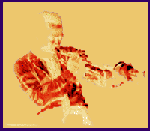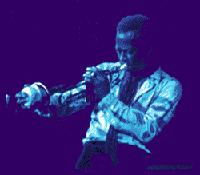|
Highlight
Blue in Green is one of the most simultaneously sad and glorious pieces of music I have ever heard. Jazz is sometimes difficult for me to access,

but Miles Davis is one of the rare few who, along with John Coltrane (who appears with Miles in the "Kind of Blue" session),
make me understand how the complexity of jazz is merely an expression of the simplicity of nature.
Deeper
It is both astonishing and logical that certain artists can spontaneously express what is a perfect mathematical expression. In its clinical form, it appears as a
specific pattern of numbers, while in its sublime form--a blueprint of emotion capable of moving hearts
to tears and spirits to soaring.
It is through exercises such as Miles Davis' Blue in Green that I am convinced science (math), music, and emotion are the same thing--suggesting no separation between mind (perceived as esoteric) and body (embodiment of the empiric).
Follow Ups
Quote from Frank Zappa: "Jazz isn't dead. It just smells funny."
When is music inside and when is it outside? In the lexicon
of music, the inside player is the one who sticks with a melody
that follows a traditional scale. The outside player is the
one whose dissonance outside of the scale creates its own
melody. Zappa was particularly effective in many of his compositions
when playing outside of the scale. Miles Davis did much of the
same, especially with Bitches Brew when rhtymic variations also set
the tonal quality of being "outside" the center of the piece.
Yet why is it that many of these pieces and artists remain
"inaccessable" to many listeners? To appreciate the condition
of being outside, does one need to have a dissociative experience
in their life? Or is it that as we grew we developed diminished egos
and thereby we lost the great mediator between the id and super ego?
For didn't Hesse express these great variations in which he and his
characters vacillated between the inside, as in self absorbtion and
preoccupation, and the outside, or hedonistic pleasure seeking in which
our inhibitions were lost and we cared not for moral strictures?
Steppenwolf jumping through the door that led him to homoerotic pleasure
despite his firm belief he couldn't possibly engage in such activity?
How did he step outside himself, Steppenwolf that is? Was he
prompted by the effects of others around him and the music and jazz he
heard? Or was it ultimately the narcotic cocktail that provided
the requisite destruction of his self-imposed boundaries between
that which he thought was inside and what he knew was outside?
-- Follow up by Richard
The Skin of Music - Played by "Ms. Noa Guy"
Added as a follow up to Freedom and Music:
The clarinet sound is vague but beautiful. It is accompanied by strings, playing soft and dense clusters. The clarinet gets more and more elaborate and the sound of the strings fades into the background. It would be hard to write it all. The music paper lies in front of me on the desk and is between me and the music, between me and the players. The melody of the clarinet becomes clearer and the hand grabbs the pencil and begins to write, slow and careful. I hear it all inside me and the my hands puts it on the paper. The strings clusters become more dense and rich with rising pitch and after a while subside to a mellow moan of sorrow. It envelops the melody of the clarinet in a velvety sound and the mix sounds wonderful and pieceful at the end. When it is
played on stage I am surprised. How did my hand managed to convey my inner musical thought to these people on the stage? Where is the magic? And all these people in the hall are listening so attentively. I give them the gift of my sounds and dreams.
-- "Ms. Noa Guy"
It was definately the jazz. --Erik J. Lundquist in response to Richard with the following picture.

|





